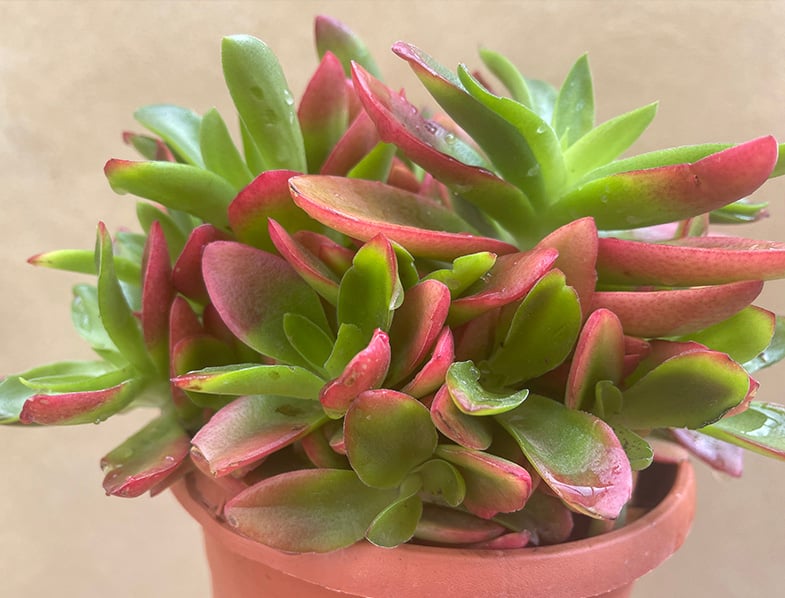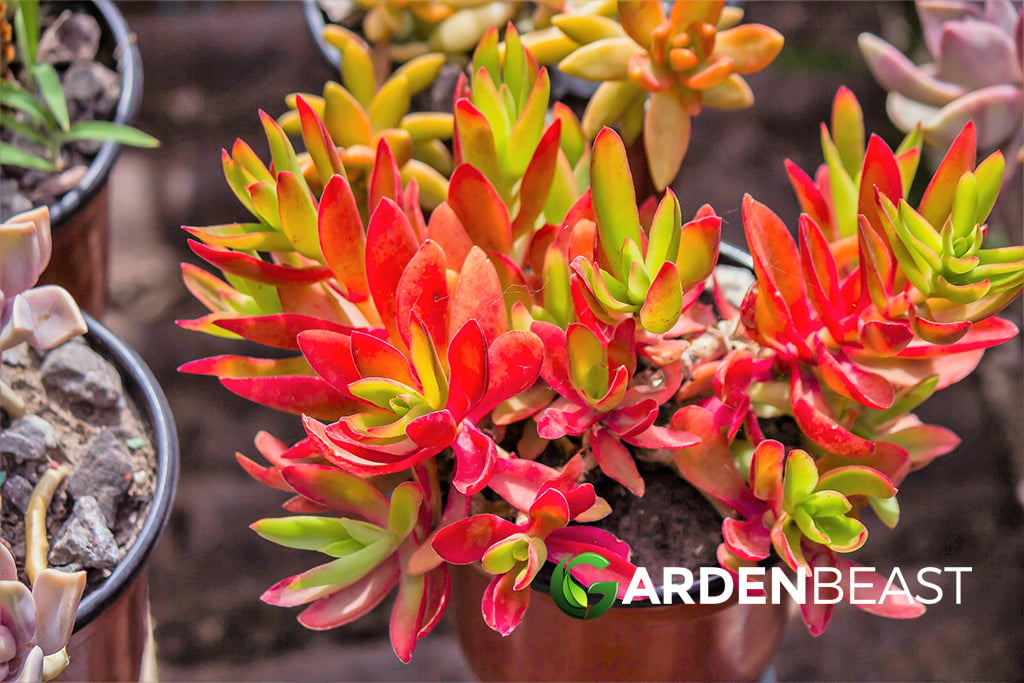Read our complete guide to Crassula Red Pagoda for everything you will ever need to know! Tips for planting and caring for “Crassula Capitella.”
Succulents come in a variety of shapes and sizes to suit any grower. There are approximately 150 species in the Crassula genus, each one more astonishing than the previous. The genus also contains the very common jade plant – crassula ovata. And while the jade plant is a beautiful succulent on its own, it’s hard to match the “wow” effect of Crassula pagoda plants. The succulent aficionados will like the piled triangular leaves with crimson and fine prickly spines. For succulent and collection-obsessed gardeners, growing at least one Crassula Red Pagoda is an absolute must!
Whether you’re a seasoned plant grower with a passion for succulents or a total newbie and you want to try your hand at succulent gardening, once your eyes fall on a crassula red pagoda, there’s no coming back. This succulent species has a unique look, catching anyone’s attention and inviting you to take her home.
This one-of-a-kind plant conjures up thoughts of a trip to Shanghai, where religious structures represent inconceivable forms of layered architecture and astonishing building prowess. The Red Pagoda is an easy-to-grow succulent and, thanks to its beautiful shape, it will look amazing both when planted on its own or in a succulent display.
Whether you’ve already got your hands on a crassula red pagoda or are considering adding one to your collection, it’s beneficial to learn how to care for this lovely gem of a plant. Giving your succulent the proper care from the start until it is comfortable in its new environment will be rewarding in many ways.
About Crassula Red Pagoda
- While most of us know this unique-looking succulent as Crassula Red Pagoda, the plant’s scientific name is Crassula Capitella
- This succulent gets its name from the pink-red rosettes it produces, which stack on top of each other in a pagoda form
- Although the Red Pagoda loves well-drained soil, it may also thrive when planted in improved clay soil or even a soilless mix. Some succulent lovers also make their own soli, with one part perlite, two parts sand, and three parts potting soil mixed together.
- Crassula Capitella is a South African native that thrives in the provinces of Eastern Cape, Namibia, and Botswana. The indigenous inhabitants of South Africa recognize the plant as a herb whose roots are dried and grounded into a powder used to treat wounds.
- A crassula red pagoda is a perfect addition to rock gardens hanging baskets or can even be used as groundcover.
- This plant is almost disease-free, but look out for mealybugs and aphids.

Crassula Red Pagoda Features: An Overview
- Red pagoda’s stems can grow up to 8 inches long and 18 inches wide
- If you are lucky and care for your red pagoda well enough, it will bloom tiny, white flowers during summer and fall – a true gift for any plant lover and a real attraction for pollinators such as butterflies and bees.
- Small, pointed, thick leaves are tightly packed on top of each other and linked to a stem on this evergreen succulent—these leaves stack to form a pagoda-like appearance.
- The crassula red pagoda is toxic for animals, so be sure to keep pets away from its leaves.
Growing Crassula Red Pagoda
The thick fleshy leaves of the Red Pagoda are spirally arranged and edged with vivid pink, red, or orange. Each fresh leaf rosette grows on top of the previous rosette. The new leaves are primarily green and little at first, but as you look down the plant’s stem, they get bigger and brighter in colour. It’s almost as if you’re peering through a ribbed tunnel with deep colours. Because of the triangular serrated pads, the plant is also known as shark’s teeth.
The Crassula Red Pagoda will put on a blazing spectacle of red colours if it receives full sunshine for at least four hours in the morning, yet it will also flourish in less light. Leaves can become brown when exposed to direct sunlight at midday in harsh conditions for lengthy periods of time.
These succulents will thrive in the south-facing portion of your apartment or yard, or in any location that receives the most sunshine. Reduce the amount of time your pagoda is exposed to the sun if it starts to develop wrinkled or spotty rosettes.
Crassulas thrive when air can freely move around them. If you like terrariums and have planted your red pagoda in one, leave it open and keep it out of direct sunlight. If you keep it in too much sun, the glass becomes overheated, causing brown blotches on the leaves. Clip any patchy leaves you find off the stem and apply fungicide to the incision to avoid fungus.
To extend the life of your Crassula Capitella, trim and replant your succulent once it blooms. To keep your succulent’s pleasing and lovely appearance, remove old foliage with a sharp, clean knife before the new leaves develop. You may break up the clumps and direct the succulent to grow in the direction you want every two to three years, especially in the early springtime, to truly keep your crassula red pagoda healthy.
This succulent might benefit from using organic compost fertilizer twice a year or more frequently if the soil is deficient.
Planting Crassula Red Pagoda
To ensure your red pagoda will grow healthy, it is recommended that you use well-drained soil mixed with sand. If you want to avoid pests and other soil-related issues, a soilless mix. These soil mixes can be created at home by adding coconut husk, perlite, and ground barks in equal parts to the pot, then mixing everything together.
If you don’t want to add sand in soil mixtures, it can be replaced with crushed granite, pumice, chicken grit, calcined clay, or perlite to improve aeration and drainage.

Crassula capitella Plant Seeds
Keep in mind that Crassula Capitella is not a cold-hardy plant. As a result, if you reside anywhere where the temperature falls below 30 degrees Fahrenheit, you should cultivate them as indoor plants only.
Agave, Echeveria, and Sempervivum are all good companion plants for Crassula Capitella as they have similar needs. You may also pair your Crassula Red Pagoda succulents with dormant summer plants like Aeonium, Aloes, or Kalanchoes.
Watering Crassula Red Pagoda
No matter how loyal we strive to be to our green pals, things don’t always go as planned. For example, they may be without water for a brief period of time, but the forgiving crassula red pagoda turns out to be a fantastic companion in this regard! Succulents usually store water in their leaves, but this plant is able to do even more. The Crassulacean Acid Metabolism (CAM) allows the succulent to open its stomata at night instead of during the day to absorb carbon dioxide, reducing internal moisture loss due to evaporation. The resilience of the plant allows it to grow and live in drought-prone environments.
However, out of too much care, plat enthusiasts sometimes overwater their prized succulents, which can cause permanent root damage. To avoid this and keep your red pagoda healthy, allow the soil to totally dry before watering. To evaluate soil moisture, purchase a moisture sensor for plants and stick it in the soil; if it points to “dry,” water your succulent until the pointer reaches “wet.” Wait for the plant to completely dry out, which might take up to a week in mild temperatures.
Propagating Crassula Red Pagoda
After your crassula red pagoda reaches two-three years of age and becomes a mature plant, you can start duplicating this enthusiastic succulent. Cutting, offsetting, and dividing are the three options available to you.
Red Pagoda, like other succulents, is very easy to propagate from cuttings. You can cut a leaf and put it in the soil after applying fungicide. Allow a few days for the cutting to callus before placing it in a soilless media. The plant will root in a month or two and can be relocated to a display pot or the garden.

You can also propagate through offsets – which are tiny plant babies developing at the base of the parent plant and that can readily grow on their own after being separated from the original plant. After separating the baby plants, let them air dry for a few days to allow the cut edges to heal. The chopped stems should then be placed in a new container with fresh soil mix. Begin by softly watering them, and they will start to grow roots over time.
Another approach is to dig out the entire plant, separate it from the root with a disinfected knife, and then plant the two halves together, roots fanned out into the soil.
In Conclusion
Before we conclude, we hope you have gained a better understanding of Crassula capitella plants. As you can see, this lush succulent does not require a lot of time or work. Your Crassula Red Pagoda will spiral into red-tinted rosettes with just a little bit of care.
To summarize, all you have to do is meet their fundamental growth requirements, and they will reward you with healthy plants and pretty flowers. You’ll be able to effortlessly look after them with just a bit of basic plant care. Furthermore, propagating these succulents is a simple and rewarding process. So, hurry up, start cultivating your own pagoda plant, and then tell us about your experiences!
